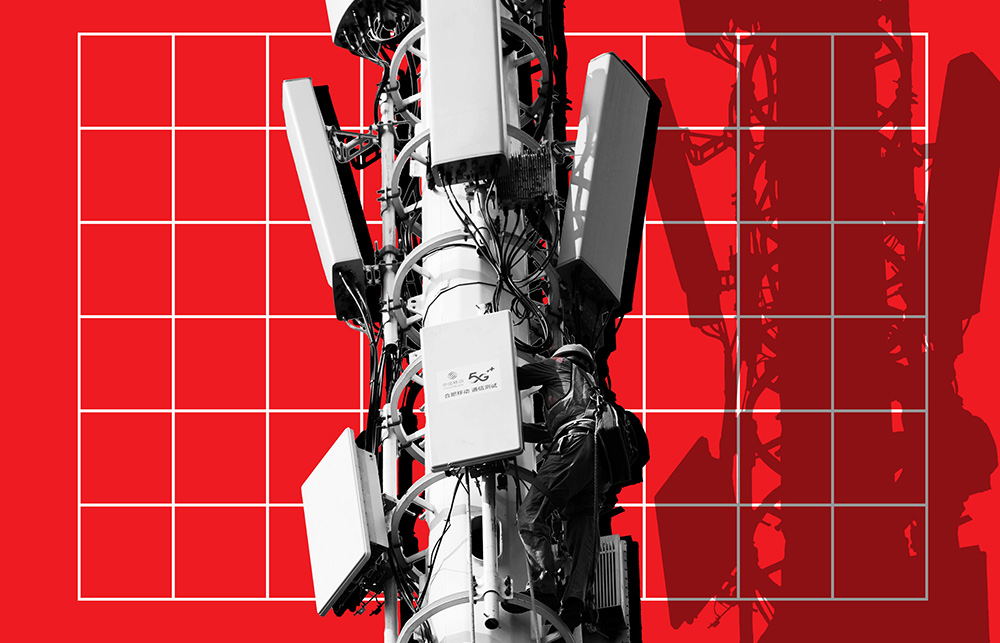
雖然2020年帶來的挑戰(zhàn)出乎所有人的意料,,但近期新興科技的發(fā)展使全世界的企業(yè)能夠迅速響應(yīng),,適應(yīng)未知的領(lǐng)域,。無論是虛擬會(huì)議還是遠(yuǎn)程辦公,我們看到我們的工作方式和消費(fèi)者的行為都發(fā)生了顯著的變化,。
流媒體和在線購物的增長以及面對(duì)面社交的減少,從個(gè)人生活和工作這兩個(gè)方面,,提高了消費(fèi)者對(duì)于可靠,、快速的虛擬溝通方式的需求。據(jù)估計(jì),,美國現(xiàn)有工作人口超過一半目前為遠(yuǎn)程辦公,。在疫情期間居家辦公的美國工作者中,五分之三更愿意繼續(xù)遠(yuǎn)程辦公,。
消費(fèi)者工作、社交和消費(fèi)商品與服務(wù)的方式發(fā)生轉(zhuǎn)變,,正在迫使制造商重新思考如何解決當(dāng)前最大的消費(fèi)者痛點(diǎn):保持網(wǎng)絡(luò)通暢,。
在2020年以前,科技公司投入巨資研發(fā)下一代網(wǎng)絡(luò)技術(shù):5G,。這項(xiàng)新技術(shù)將給消費(fèi)者帶來許多好處,,比如媲美光纖的網(wǎng)速、更可靠的連接,、更流暢的流媒體播放和更少緩沖的視頻通話等,。(摩托羅拉(Motorola)在一年多以前發(fā)布了第一款支持5G網(wǎng)絡(luò)的手機(jī),,這款手機(jī)使用了高通技術(shù)公司(Qualcomm Technologies)的第一款商用5G芯片。隨著5G產(chǎn)品的普遍應(yīng)用,,這兩家公司將從中受益,。)
但那是未來的情景。我們目前的狀況如何,?
科技公司和其他行業(yè)參與者正在全球擴(kuò)建5G網(wǎng)絡(luò)。愛立信(Ericsson)的預(yù)測稱,,5G網(wǎng)絡(luò)的普及速度將明顯超過2009年的LTE(4G)。2009年,,LTE技術(shù)開始成為主流。預(yù)計(jì)截至2021年底,,25%至30%的消費(fèi)者每周將有數(shù)天繼續(xù)遠(yuǎn)程辦公,,我們需要解決的問題是如何幫助更多消費(fèi)者保持網(wǎng)絡(luò)通暢,?
手機(jī)廠商可以推出不同價(jià)位的產(chǎn)品,,解決當(dāng)前采用5G技術(shù)所面臨的障礙,使用戶可以連接到所謂的sub-6頻段或毫米波頻段的5G網(wǎng)絡(luò),,這意味著用戶可以連接到各自市場可用的5G網(wǎng)絡(luò),。雖然早期的5G智能手機(jī)頻譜兼容性受限并且售價(jià)高昂,但2020年推出的手機(jī)將面向廣大消費(fèi)者,。
然而,僅靠增加5G設(shè)備和拓寬網(wǎng)絡(luò),,并不足以解決當(dāng)前消費(fèi)者對(duì)保持網(wǎng)絡(luò)通暢的需求,??萍夹袠I(yè)必須開發(fā)其他5G應(yīng)用,影響消費(fèi)者的日常行為,。
一種方式是在全球發(fā)展遠(yuǎn)程醫(yī)療。通過5G網(wǎng)絡(luò)能夠以虛擬的方式協(xié)助遠(yuǎn)程問診和手術(shù),,將幫助醫(yī)療服務(wù)提供商提供患者需要的治療,,同時(shí)減少相關(guān)成本。有了5G網(wǎng)絡(luò),,患者還可以配備監(jiān)控工具,,測量重要的生命體征、藥物治療依從性等,,讓醫(yī)生能夠查看更準(zhǔn)確的實(shí)時(shí)患者信息,從而提供更加個(gè)性化的治療方案,。
5G網(wǎng)絡(luò)還可以為消費(fèi)者帶來日益虛擬化的購物體驗(yàn),。5G網(wǎng)絡(luò)支持更出色的虛擬現(xiàn)實(shí)和增強(qiáng)現(xiàn)實(shí)體驗(yàn)。例如,,購物者不需要觸碰商品或者走出家門,,就能夠試穿衣服和選擇家具。
與4G網(wǎng)絡(luò)實(shí)現(xiàn)GPS跟蹤和實(shí)時(shí)流媒體播放需要時(shí)間一樣,,5G網(wǎng)絡(luò)還有各種優(yōu)勢有待挖掘,。未來仍然有很多工作要做,但我們相信到2020年底,,5G網(wǎng)絡(luò)會(huì)在更多的地方普及,。到時(shí)候,5G技術(shù)將在全世界帶來大量機(jī)會(huì),。(財(cái)富中文網(wǎng))
克里斯蒂亞諾?阿蒙為高通總裁,。
塞爾吉奧?布尼亞克為摩托羅拉總裁。
譯者:Biz
克里斯蒂亞諾?阿蒙與塞爾吉奧?布尼亞克寫道,,新冠疫情刺激摩托羅拉和高通等公司開始考慮如何普及5G技術(shù),。
雖然2020年帶來的挑戰(zhàn)出乎所有人的意料,但近期新興科技的發(fā)展使全世界的企業(yè)能夠迅速響應(yīng),,適應(yīng)未知的領(lǐng)域,。無論是虛擬會(huì)議還是遠(yuǎn)程辦公,我們看到我們的工作方式和消費(fèi)者的行為都發(fā)生了顯著的變化,。
流媒體和在線購物的增長以及面對(duì)面社交的減少,,從個(gè)人生活和工作這兩個(gè)方面,提高了消費(fèi)者對(duì)于可靠,、快速的虛擬溝通方式的需求,。據(jù)估計(jì),,美國現(xiàn)有工作人口超過一半目前為遠(yuǎn)程辦公,。在疫情期間居家辦公的美國工作者中,五分之三更愿意繼續(xù)遠(yuǎn)程辦公,。
消費(fèi)者工作,、社交和消費(fèi)商品與服務(wù)的方式發(fā)生轉(zhuǎn)變,正在迫使制造商重新思考如何解決當(dāng)前最大的消費(fèi)者痛點(diǎn):保持網(wǎng)絡(luò)通暢,。
在2020年以前,,科技公司投入巨資研發(fā)下一代網(wǎng)絡(luò)技術(shù):5G,。這項(xiàng)新技術(shù)將給消費(fèi)者帶來許多好處,比如媲美光纖的網(wǎng)速,、更可靠的連接,、更流暢的流媒體播放和更少緩沖的視頻通話等,。(摩托羅拉(Motorola)在一年多以前發(fā)布了第一款支持5G網(wǎng)絡(luò)的手機(jī),,這款手機(jī)使用了高通技術(shù)公司(Qualcomm Technologies)的第一款商用5G芯片。隨著5G產(chǎn)品的普遍應(yīng)用,,這兩家公司將從中受益。)
但那是未來的情景,。我們目前的狀況如何?
科技公司和其他行業(yè)參與者正在全球擴(kuò)建5G網(wǎng)絡(luò),。愛立信(Ericsson)的預(yù)測稱,5G網(wǎng)絡(luò)的普及速度將明顯超過2009年的LTE(4G),。2009年,LTE技術(shù)開始成為主流,。預(yù)計(jì)截至2021年底,,25%至30%的消費(fèi)者每周將有數(shù)天繼續(xù)遠(yuǎn)程辦公,我們需要解決的問題是如何幫助更多消費(fèi)者保持網(wǎng)絡(luò)通暢,?
手機(jī)廠商可以推出不同價(jià)位的產(chǎn)品,解決當(dāng)前采用5G技術(shù)所面臨的障礙,,使用戶可以連接到所謂的sub-6頻段或毫米波頻段的5G網(wǎng)絡(luò),,這意味著用戶可以連接到各自市場可用的5G網(wǎng)絡(luò)。雖然早期的5G智能手機(jī)頻譜兼容性受限并且售價(jià)高昂,,但2020年推出的手機(jī)將面向廣大消費(fèi)者。
然而,,僅靠增加5G設(shè)備和拓寬網(wǎng)絡(luò),并不足以解決當(dāng)前消費(fèi)者對(duì)保持網(wǎng)絡(luò)通暢的需求,。科技行業(yè)必須開發(fā)其他5G應(yīng)用,,影響消費(fèi)者的日常行為。
一種方式是在全球發(fā)展遠(yuǎn)程醫(yī)療,。通過5G網(wǎng)絡(luò)能夠以虛擬的方式協(xié)助遠(yuǎn)程問診和手術(shù),將幫助醫(yī)療服務(wù)提供商提供患者需要的治療,,同時(shí)減少相關(guān)成本。有了5G網(wǎng)絡(luò),,患者還可以配備監(jiān)控工具,測量重要的生命體征,、藥物治療依從性等,讓醫(yī)生能夠查看更準(zhǔn)確的實(shí)時(shí)患者信息,,從而提供更加個(gè)性化的治療方案,。
5G網(wǎng)絡(luò)還可以為消費(fèi)者帶來日益虛擬化的購物體驗(yàn)。5G網(wǎng)絡(luò)支持更出色的虛擬現(xiàn)實(shí)和增強(qiáng)現(xiàn)實(shí)體驗(yàn),。例如,,購物者不需要觸碰商品或者走出家門,,就能夠試穿衣服和選擇家具。
與4G網(wǎng)絡(luò)實(shí)現(xiàn)GPS跟蹤和實(shí)時(shí)流媒體播放需要時(shí)間一樣,,5G網(wǎng)絡(luò)還有各種優(yōu)勢有待挖掘。未來仍然有很多工作要做,,但我們相信到2020年底,5G網(wǎng)絡(luò)會(huì)在更多的地方普及,。到時(shí)候,5G技術(shù)將在全世界帶來大量機(jī)會(huì),。(財(cái)富中文網(wǎng))
克里斯蒂亞諾?阿蒙為高通總裁,。
塞爾吉奧?布尼亞克為摩托羅拉總裁,。
譯者:Biz
While 2020 has introduced challenges no one expected, recent advances in emerging tech have enabled companies worldwide to quickly react and adapt in uncharted territory. Whether it involves switching to virtual meetings or managing companies remotely, we’ve seen a distinct change in the way we work, and simultaneously in consumer behavior.
Increased streaming and online shopping and less in-person socializing have led to consumers’ growing need for a reliable and quick way to virtually communicate on both a personal and professional level. In the U.S., it’s estimated that more than half of the current workforce is working remotely—and three in five U.S. workers who have been doing their jobs from home during the pandemic would prefer to continue doing so.
This shift in how consumers are working, socializing, and consuming products and services is forcing manufacturers to rethink how to solve one of today’s biggest consumer pain points: staying connected.
Prior to 2020, companies across the technology industry had been heavily investing in, researching, and developing the next generation of connectivity: 5G. This new technology will provide consumers with several benefits, including connection speeds that are as fast as fiber, more reliable connections, smoother streaming, and video calling with less buffering. (The first 5G-capable phone was introduced by Motorola a little more than a year ago, using the first commercial 5G chipsets from Qualcomm Technologies. Both companies stand to benefit from increased use of 5G products.)
But that’s the future. Where are we today?
Tech companies and industry players are taking part in the expansion of 5G on a global scale. A forecast from Ericsson suggests that 5G subscription uptake will be significantly faster than that of LTE (4G) in 2009, when the technology was first going mainstream. With 25% to 30% of consumers expected to continue to work remotely for multiple days a week by the end of 2021, the question becomes: How are we helping more consumers stay connected?
Mobile manufacturers can address current obstacles to 5G adoption by creating products that span various price points and enable users to connect to so-called sub-6 or mmWave 5G networks—which means they are connected to whatever flavor of 5G technology is available in their respective markets. While early 5G smartphones were offered with constricted spectrum compatibility and premium pricing, those launched in 2020 are reaching a wider consumer base.
However, broadened 5G devices and networks alone won’t solve the current consumer need to stay connected. The technology industry must develop other 5G applications that will impact the everyday consumer.
One way to accomplish that is by opening the doors to telemedicine at a global scale. By virtually assisting remote consultations and surgeries, 5G will help health providers offer remote access to the care that patients need, as well as alleviate some of the associated costs. The 5G network will also equip patients with monitoring tools that measure vital signs, medication adherence, and more, giving doctors a more accurate, real-time look at a patient’s information—and providing for a more personalized care experience.
5G can also help the consumer shopping experience become increasingly virtual. 5G will enable better virtual and augmented reality experiences. For example, shoppers will be able to try on clothing and choose furniture without ever touching the products or leaving their house.
Just as it took time for 4G to enable GPS tracking and real-time streaming, the full swath of 5G’s benefits is yet to be realized. While a lot of work still needs to be done, we’re confident that by the end of 2020, we’ll see 5G reaching more people in more places. Once it does, the opportunities that come from 5G will be global in scale.
Cristiano Amon is president of Qualcomm.
Sergio Buniac is president of Motorola.






